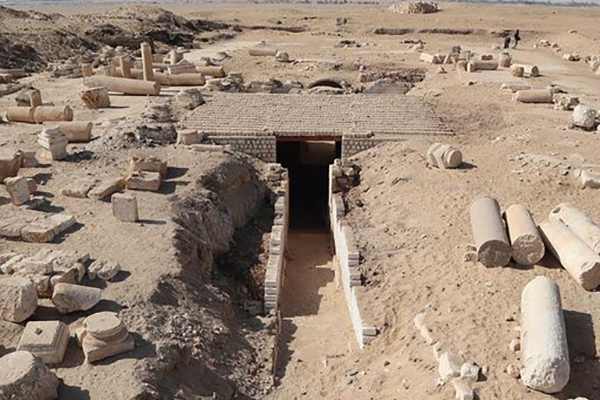New findings in Oxyrhynchus

On Monday 20 February, Maite Mascort and Esther Pons, co-directors of the Oxyrhynchus Archaeological Mission (Egypt) of the Institute of Ancient Near East of the University of Barcelona, presented the results (archaeological, anthropological and restoration) of this mission in 2022 at the Faculty of Philology and Communication. The presentation will continue on Monday 27 February, led by the director of the IPOA, Ignasi Xavier Adiego.

On Monday 20 February, Maite Mascort and Esther Pons, co-directors of the Oxyrhynchus Archaeological Mission (Egypt) of the Institute of Ancient Near East of the University of Barcelona, presented the results (archaeological, anthropological and restoration) of this mission in 2022 at the Faculty of Philology and Communication. The presentation will continue on Monday 27 February, led by the director of the IPOA, Ignasi Xavier Adiego.
On 7 March, the exhibition “Oxirrinc, el llegat del nostre passat” (Oxyrhynchus, the legacy of our past) will be inaugurated, which brings together the thirty years of the UB’s archaeological mission in Egypt. The exhibition will be attended by the curators Maite Mascort and Núria Castellano; the Vice-Rector for Cultural Heritage and Activities, Agustí Alcoberro; the Vice-Rector for Doctoral Studies and Research Staff, Núria Feliu; and the Vice-Rector for Entrepreneurship, Innovation and Transfer, Mercè Segarra. The exhibition, which will remain open until 21 April, shows the uniqueness and relevance of this valuable archaeological site with the aim of bringing it closer to society and highlights the recognition of archaeology and Egyptology as sciences in which the concurrence of very diverse specialists and professionals is essential, making an archaeological campaign a complex but exciting experience.
The interventions of the 2022 campaign were focused on one of the most important and relevant areas of the site: the Upper Necropolis. The many unpublished findings have presented new scientific hypotheses and will enable researchers to advance in the knowledge and study of this area. There have been works in four sectors of this necropolis and both archaeological and anthropological studies have been carried out on the exhumed individuals, as well as important tasks on the consolidation and restoration of wall paintings of sector 24 and the several objects that were recovered during the excavation.
In sector 39, one of the newly excavated sectors, sixteen individual graves belonging to the Byzantine Christian period were found. These were funerary structures with a generally rectangular superstructure, which housed an individual inside a burial well. Many of the bodies were protected by a decorated shroud. The most important finding is the discovery of two offerings consisting of two frogs inside two jars, which shows the survival and syncretism of ancient Egyptian traditions in the Christian world. The first of the jars did not have a stopper and the body of the jar was apparently cut out in order to insert the contents. The cut-out fragment was then replaced and the interior was sealed and watertight. When the lid fragment was removed, the well-preserved and fully articulated skeleton of a frog about six centimetres long was discovered.
Archaeological works were resumed in sector 22, which had been halted due to security problems with the funerary structures, built with stone blocks. Although work has had to be carried out on the upper platforms, the large amount of archaeological material that has been found opens up new expectations for the study of this area.
As in previous years, sector 36 presents an interesting funerary complex from the Roman period (tombs 52, 56 and 57, and structure 58), as well as graves from the Persian period (tombs 59-62), located under tomb 57 and accessed by a shaft.
In sector 24, the structure of the basilica has been adapted and the consolidation and restoration of the mural paintings in the crypt has continued.
On the other hand, anthropological studies have continued, both of the mummified individuals and of the individuals briefly treated (the latter belonging to the Christian-Byzantine period); architectural consolidation, adaptation and restoration work has been carried out on various structures and areas of the site, and epigraphic studies (Greek and Coptic) of the walls of the crypt of the basilica and of the texts inscribed on papyri, ostraka, etc., have also continued.
In addition, kite aerial photographs, three-dimensional studies of structures and parts, as well as topographical studies and partial and general photogrammetric studies of the site have been carried out.
The Oxyrhynchus mission began in 1992, led by UB professor Josep Padró. The city of Oxyrhynchus, known in Pharaonic times as Per-Medjed, was one of the most important cities in Egypt in Greco-Roman times. Its remains were located in what is now al-Bahnasa, a small town 190 km south of Cairo, on the banks of the Nile called Bahr Yussef. There are no remains of the Pharaonic city left, but there is an important necropolis that was occupied for more than a thousand years, as well as vestiges of the Greco-Roman city.
UB Editions has a collection dedicated to the archaeological research in Egypt carried out at the University, named Nova Studia Aegyptiaca, and led by Professor Padró. It gathers results obtained from years of archaeological work by the UB researchers in Oxyrhynchus.
